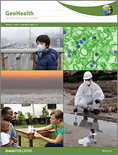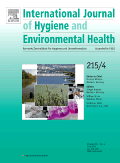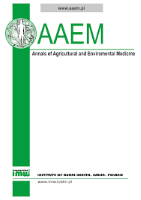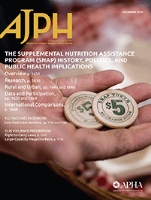
GeoHealth
Scope & Guideline
Innovating Solutions for Health in a Changing Planet
Introduction
Aims and Scopes
- Environmental Health Assessment:
Researching the effects of environmental pollutants (like PM2.5, ozone, and heavy metals) on human health, focusing on exposure pathways and health outcomes. - Climate Change and Health:
Investigating the implications of climate change on health, including the impacts of extreme weather events, temperature fluctuations, and changing ecosystems on public health. - Social Vulnerability and Health Disparities:
Examining how social determinants (such as race, socioeconomic status, and urbanization) influence health outcomes related to environmental exposures. - Geospatial and Machine Learning Methods:
Employing advanced statistical, geospatial, and machine learning techniques to analyze complex data sets and model health impacts from environmental factors. - Public Health Policy and Interventions:
Exploring the effectiveness of public health policies and interventions aimed at reducing environmental health risks, including community engagement and participatory research.
Trending and Emerging
- Climate Change Adaptation Strategies:
Increasing focus on adaptation strategies to mitigate health impacts from climate change, emphasizing resilient public health systems and community-level interventions. - Impact of Extreme Weather Events:
Heightened interest in understanding health outcomes associated with extreme weather events, such as floods and heatwaves, and their implications for emergency preparedness. - Integration of Citizen Science:
Emerging research utilizing citizen science to enhance data collection and community engagement in environmental health studies, promoting participatory approaches. - Mental Health and Environmental Stressors:
Growing recognition of the links between environmental factors (like climate change and pollution) and mental health outcomes, leading to more comprehensive studies in this area. - Use of Advanced Technological Tools:
Increasing incorporation of innovative technologies (like satellite remote sensing, low-cost sensors, and machine learning) to monitor environmental health and assess risks.
Declining or Waning
- Traditional Epidemiological Studies:
There is a noticeable decrease in traditional epidemiological studies that do not incorporate geospatial or environmental data, as the field moves towards more integrated and complex models. - Static Health Risk Assessments:
Research that relies on static models of health risk assessment without considering dynamic environmental changes, such as climate variability, is becoming less common. - Single-Factor Analyses:
Studies focusing solely on single environmental factors (e.g., air pollution alone) without considering interactions with socioeconomic or demographic variables are declining as the field increasingly embraces multifactorial approaches. - Historical Case Studies:
There is a waning interest in historical case studies that do not apply modern analytical techniques or that lack relevance to current public health challenges. - Localized Focus Without Broader Implications:
Research that does not connect localized environmental health issues to broader public health implications or policy discussions is less frequently published.
Similar Journals

POPULATION AND ENVIRONMENT
Bridging Population Dynamics and Environmental ChangePopulation and Environment is a renowned journal published by Springer, focusing on the critical intersection between demographic processes and environmental changes. Established in 1980, the journal has become a leading platform for interdisciplinary research, with its impressive impact reflected in its 2023 rankings, placing it in the Q1 quartile for both Demography and Environmental Science (miscellaneous) categories. With Scopus Ranks highlighting its prominent position (#11 out of 139 in Social Sciences – Demography, and #46 out of 219 in Environmental Science), Population and Environment fosters a rich dialogue among researchers, professionals, and students dedicated to understanding how population dynamics influence environmental conditions and vice versa. Operating without an open access option, the journal ensures high standards for scholarly contributions and remains committed to bridging knowledge gaps in the realms of population studies and environmental science. The journal's rigorous peer-review process and comprehensive archive from 1980 to 2024 solidify its reputation as an invaluable resource for advancing research and informing policy in these critical fields.

GEOJOURNAL
Empowering Scholarship in Geography and PlanningGEOJOURNAL, published by SPRINGER, is a distinguished academic journal that occupies a pivotal role in the fields of geography, planning, and development. With a robust ISSN of 0343-2521 and an E-ISSN of 1572-9893, it has been a cornerstone of scholarly communication since its inception in 1977. Operating from the Netherlands, GEOJOURNAL offers insightful research articles that delve into the dynamics of spatial analysis, environmental management, urban studies, and regional development, thus catering to a diverse readership of researchers, professionals, and students alike. The journal boasts an impressive Scopus ranking of #176 out of 821 in its category, positioning it in the top 22% percentile while maintaining a Q2 quartile ranking in Geography, Planning, and Development as of 2023. With access options available, GEOJOURNAL remains a vital platform for disseminating cutting-edge research and fostering academic collaboration, indispensable for those engaging with contemporary geographic challenges and innovative solutions. Engage with GEOJOURNAL to enrich your understanding and contribute to critical discussions in this ever-evolving field.

Earth Systems and Environment
Bridging Disciplines to Understand Our Changing WorldEarth Systems and Environment, published by Springer International Publishing AG, is a leading peer-reviewed journal dedicated to the multidisciplinary study of natural and anthropogenic processes that shape the Earth's systems. With an impressive impact factor and consistently ranked in the Q1 category across various fields, including Computers in Earth Sciences, Economic Geology, and Environmental Science, it stands as a premier platform for researchers and professionals seeking to address pressing environmental challenges. The journal covers a wide spectrum of topics, from geology to global change, and emphasizes innovative methodologies and interdisciplinary approaches to understand and manage Earth systems. As an essential resource for scholars and practitioners, Earth Systems and Environment commits to excellence and facilitates open dialogue on critical issues affecting our planet.

INTERNATIONAL JOURNAL OF HYGIENE AND ENVIRONMENTAL HEALTH
Championing hygiene and environmental health for a sustainable future.International Journal of Hygiene and Environmental Health, published by Elsevier GmbH, stands at the forefront of research in the fields of public health, environmental, and occupational health. With an impressive impact factor that underscores its significance—ranking #30 out of 665 journals in its category, placing it within the top 5%—the journal is a vital resource for academics and professionals seeking to expand their knowledge and contribute to advancements in the field. Since its inception in 2000, the journal has continually evolved, with its Q1 quartile designation reflecting its high-quality contributions and rigorous peer-review process. Accessible to a global audience, it offers flexible open access options, promoting the dissemination of critical findings on hygiene and environmental health issues. Published in Germany, the journal serves as an essential platform for researchers, educators, and practitioners to share innovative studies, timely reviews, and insightful discussions, driving forward the dialogue on public health challenges and solutions in today's world.

Epidemiology and Health
Shaping the future of public health through rigorous research.Welcome to Epidemiology and Health, a premier open-access journal dedicated to advancing knowledge in the fields of epidemiology and public health. Published by the Korean Society of Epidemiology since 1979, this journal serves as a vital platform for researchers, professionals, and students alike, promoting innovative research and robust discussion surrounding public health issues. Based in South Korea, it boasts a commendable Q2 ranking in the categories of Epidemiology, Public Health, and Environmental and Occupational Health, reflecting its significant contribution to the scientific community. With its current impact factor ranking it favorably among peers—#124 out of 665 in Public Health and #40 out of 148 in Epidemiology—Epidemiology and Health continues to uphold its mission of disseminating high-quality, peer-reviewed research. The journal's commitment to open access ensures that vital epidemiological insights reach a broad audience, supporting the collective goal of improving global health outcomes. Engage with pioneering studies and emerging trends within these critical fields, as we work towards a healthier future.

ANNALS OF AGRICULTURAL AND ENVIRONMENTAL MEDICINE
Connecting Ecology, Health, and Sustainable PracticesANNALS OF AGRICULTURAL AND ENVIRONMENTAL MEDICINE is a prominent open access journal published by the Institute of Rural Health in Lublin, Poland, since 1998. With an ISSN of 1232-1966 and an E-ISSN of 1898-2263, the journal aims to bridge the gap between agricultural practices and environmental health insights, encouraging interdisciplinary research and discussions among professionals, researchers, and scholars. Covering a broad scope that includes Ecology, Evolution, Behavior, Public Health, and Waste Management, it has achieved a commendable position within the academic community, as reflected in its quartile rankings (Q3) across multiple theoretical fields. The journal serves as a crucial platform for disseminating innovative ideas and findings that contribute to sustainable agricultural practices and the improvement of environmental and public health. With a focus on original research, reviews, and case studies, the ANNALS OF AGRICULTURAL AND ENVIRONMENTAL MEDICINE stands out as a vital resource for ongoing scholarly discourse and practical applications in the realms of agriculture, environmental science, and medicine.

Lancet Regional Health-Americas
Exploring New Frontiers in Public Health and MedicineLancet Regional Health-Americas is a premier open-access journal published by ELSEVIER, dedicated to advancing knowledge in the fields of health policy, internal medicine, and public health within the Americas. Established in 2021, this journal has quickly risen to prominence, achieving Q1 status in renowned categories such as Health Policy, Internal Medicine, and Public Health, Environmental and Occupational Health as of 2023. With impressive rankings, including a placement of #25 out of 310 in Health Policy and #68 out of 665 in Public Health, this journal exemplifies a commitment to impactful research and dissemination of critical health knowledge. The journal is accessible to a broad audience and promotes open scientific dialogue and exchange of innovative solutions to regional health challenges. Researchers, professionals, and students alike will find Lancet Regional Health-Americas a vital resource for the latest developments and discussions shaping the health landscape in the Americas.

Air Quality Atmosphere and Health
Innovating Research at the Intersection of Environment and HealthAir Quality, Atmosphere and Health is a leading interdisciplinary journal published by Springer, focusing on the intricate relationship between air quality and public health. With roots dating back to 2008, the journal has established itself as a pivotal resource for researchers and professionals in the fields of Atmospheric Science, Health, Toxicology and Mutagenesis, and Pollution Management and Policy, achieving a commendable Q2 ranking across multiple categories in 2023. The journal’s rigorous peer-review process ensures that it publishes high-quality research that addresses contemporary challenges in air quality management and its impact on health outcomes. With no Open Access option, the journal maintains a model that prioritizes valuable insights for subscription holders, making it an essential reference point for advancing knowledge on environmental health issues. The journal is based in the Netherlands and contributes significantly to the understanding of atmospheric pollutants and their effects, evidenced by its strong Scopus rankings, positioning it in the top percentiles of various environmental science categories.

BIOMEDICAL AND ENVIRONMENTAL SCIENCES
Advancing the Intersection of Health and Environment.Biomedical and Environmental Sciences is a distinguished peer-reviewed journal dedicated to the advancement of knowledge in the fields of health, toxicology, public health, and environmental sciences. Published by the Chinese Center for Disease Control & Prevention, this journal has been a vital platform for researchers and professionals since its inception in 1988, contributing to interdisciplinary discussions and the dissemination of pertinent research findings up to the current year, 2024. With an ISSN of 0895-3988 and an E-ISSN of 2214-0190, it holds a respectable position in the Q3 category for both Health, Toxicology and Mutagenesis, and Public Health, Environmental and Occupational Health, indicating its relevance and contribution to these significant domains. Although this journal does not offer open access, it remains an essential resource for anyone interested in understanding the intricate interplay between biomedical research and environmental health challenges. As it continues to navigate the complexities of contemporary health issues, Biomedical and Environmental Sciences is poised to facilitate vital discussions and innovations in the pursuit of improved public health outcomes globally.

AMERICAN JOURNAL OF PUBLIC HEALTH
Advancing public health knowledge for a healthier tomorrow.The American Journal of Public Health, published by the American Public Health Association, stands as a cornerstone in the field of public health and epidemiology since its inception in 1949. With its rigorous peer-review process and a robust commitment to advancing knowledge and research practices, this journal holds a prestigious position in the academic community, as reflected in its 2023 Scopus ranking, where it is placed in the top percentile (93rd) within the categories of Public Health and Environmental and Occupational Health. The journal's focus encompasses a broad spectrum of public health topics, making it essential reading for researchers, practitioners, and students dedicated to improving population health. Subscribers can access invaluable insights through its collection of innovative studies and reviews, thereby reinforcing the journal's role in shaping public health policy and practice. By bridging research and real-world application, the American Journal of Public Health remains a vital resource for those engaged in the quest to improve health outcomes across diverse communities.